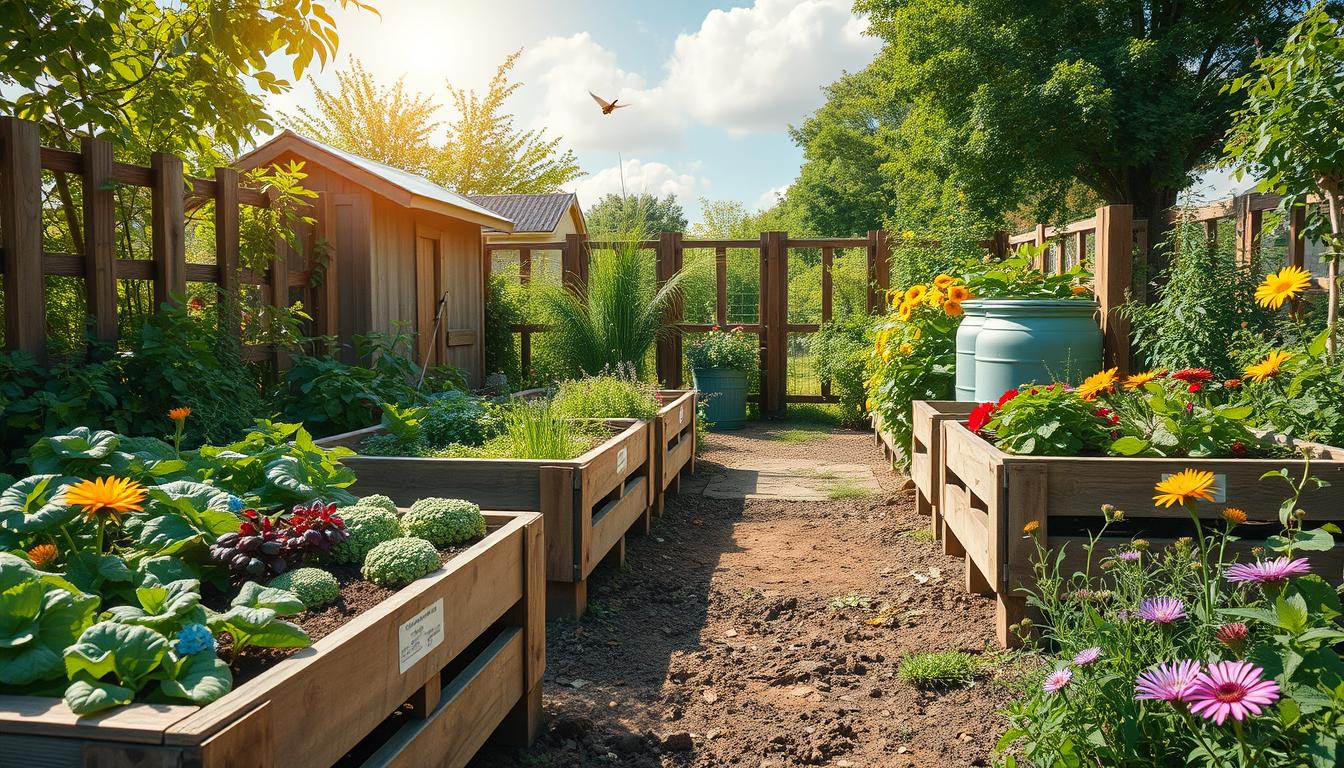Creating a sustainable garden is more than just growing plants. It’s about building an eco-friendly ecosystem that takes care of itself. To start, you need to know the basics of sustainable gardening.
This article will teach you how to make a garden that’s not only green but also helps the planet. You’ll learn how to grow your own food and reduce your carbon footprint. It’s all about making your garden a sustainable haven.
Understanding Sustainable Gardening
As I explore gardening, I see how vital eco-friendly methods are. Sustainable gardening aims for a balanced ecosystem. It uses organic practices like composting and rainwater harvesting to lessen our garden’s environmental impact.
One big plus of sustainable gardening is saving water. Techniques like drip irrigation and mulching help us use less water. It also boosts biodiversity, which is key for a healthy ecosystem. Organic practices help our gardens become lively spaces for many plants and animals.
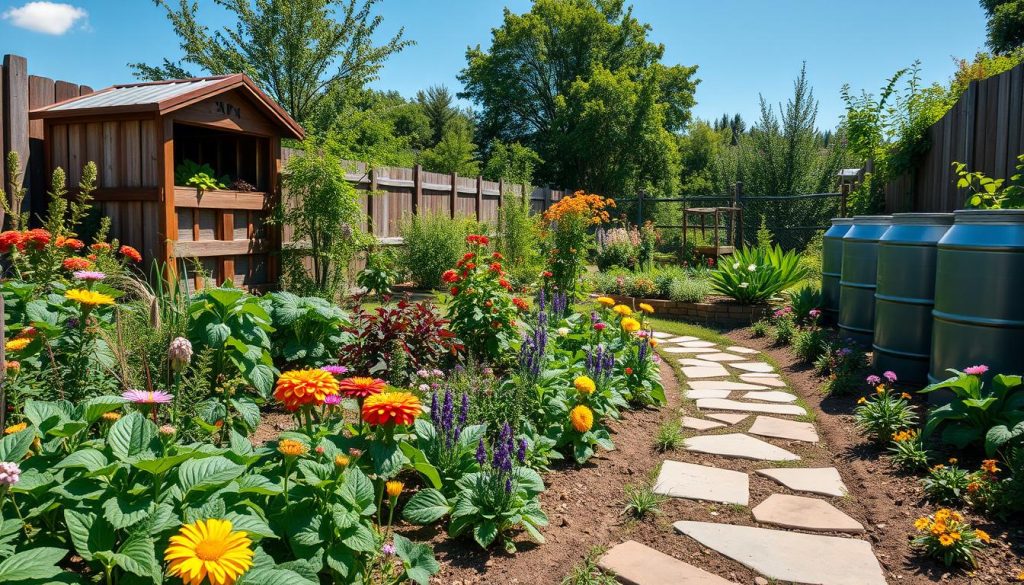
- Using natural fertilizers and pest control methods
- Conserving water through efficient irrigation systems
- Creating a diverse and thriving ecosystem
- Reducing waste and minimizing environmental impact
By following these principles, we can make a garden that’s good for the planet. It also becomes a beautiful, lively space for us to enjoy.
Exploring sustainable gardening, we find many benefits. It helps us reduce our environmental impact and creates a vibrant ecosystem. Sustainable gardening is a great choice for gardeners at any level.
| Benefits of Sustainable Gardening | Description |
|---|---|
| Reduced Water Consumption | Conserving water through efficient irrigation systems |
| Increased Biodiversity | Creating a diverse and thriving ecosystem |
| Improved Soil Health | Using natural fertilizers and pest control methods |
Choosing the Right Location
Choosing the right spot for a sustainable garden is key. I look at sunlight and soil to make sure my garden grows well. A good garden design should also respect nature and reduce its environmental impact.
For a start, I check my yard’s conditions. Here are some important things to think about:
- Sunlight: Most plants need at least 6 hours of direct sunlight a day.
- Soil: I test my soil type and pH level to pick the best plants.
- Accessibility: I pick a spot that’s easy to get to and care for.
- Aesthetics: I think about how my garden will look and fit with my landscape.
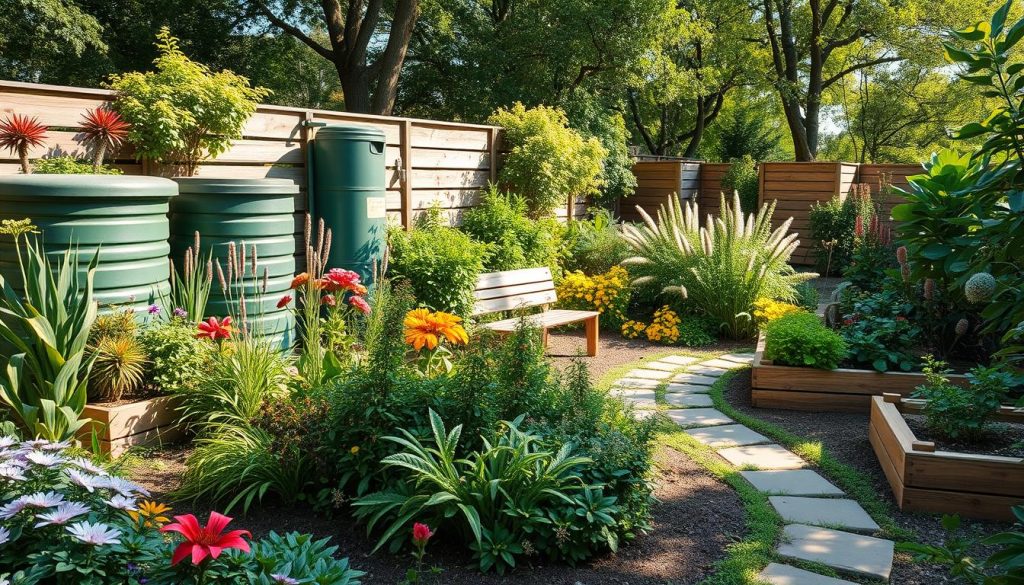
By thinking about these points and using eco-friendly gardening, I can make a garden that’s good for me and the planet. Sustainable garden design is about finding a balance between beauty and usefulness. I’m excited to start my garden journey.
| Factor | Considerations |
|---|---|
| Sunlight | 6 hours of direct sunlight per day |
| Soil | Test soil type and pH level |
| Accessibility | Easy to reach and maintain |
| Aesthetics | Visual appeal and landscape fit |
Selecting Native Plants for Your Garden
Creating a sustainable garden is all about choosing the right plants. Native plants are key to a thriving garden that also helps the local ecosystem. They need less water and care, making your garden better for the planet.
Native plants fit well with the local climate and soil. This means they fight off pests and diseases better. So, you won’t need as many chemicals. Favorites like coneflowers, black-eyed susans, and milkweed bring color and attract bees and butterflies.
Why Native Plants Matter
Native plants are crucial for biodiversity and local wildlife. They help create a home for birds, bees, and other insects. This makes your garden more beautiful and helps the environment.
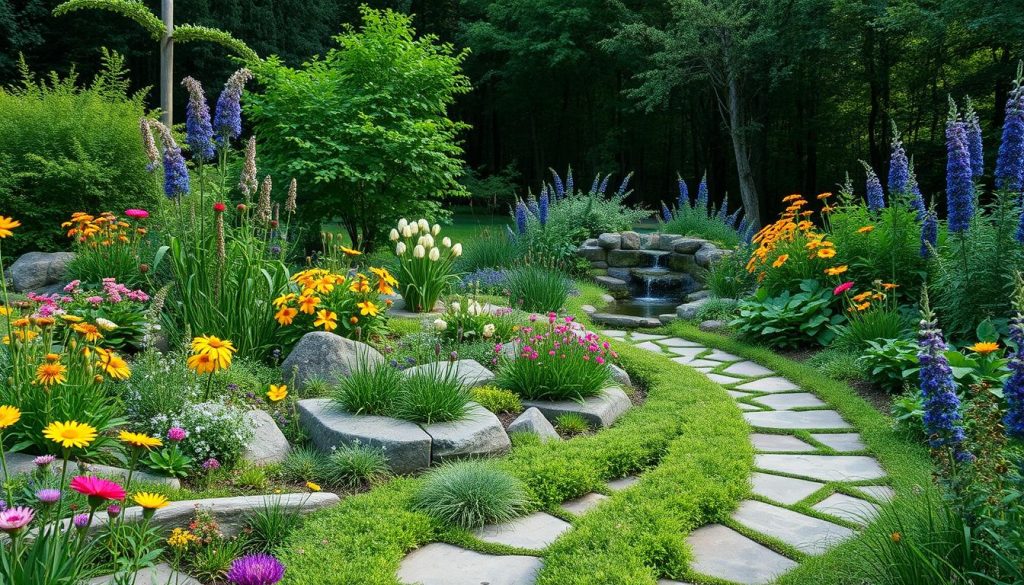
Top Native Plants for the U.S.
- Coneflowers: These drought-tolerant plants attract butterflies and bees, making them a great addition to any sustainable garden.
- Black-eyed susans: With their bright yellow petals and dark centers, these flowers add a pop of color to my garden and attract beneficial insects.
- Milkweed: This plant is essential for monarch butterflies, providing them with the nutrients they need to survive.
By choosing native plants, you can make a green garden. It will be beautiful, sustainable, and good for the local environment. Plus, it will make you feel better too.
Designing Your Garden Layout
Designing your garden layout is key to a sustainable garden. You must think about garden zones, permaculture, and companion planting. These help create a balanced and growing ecosystem. Grouping plants by their needs cuts down on fertilizers and pesticides.
Here are some tips for a sustainable garden:
- Group plants by sunlight and water needs
- Use natural patterns and reduce waste
- Plant companions to help each other grow
These tips help you build a sustainable garden. It will be beautiful, good for the environment, and give you fresh food. Always think about sustainability and follow these tips for a healthy garden.
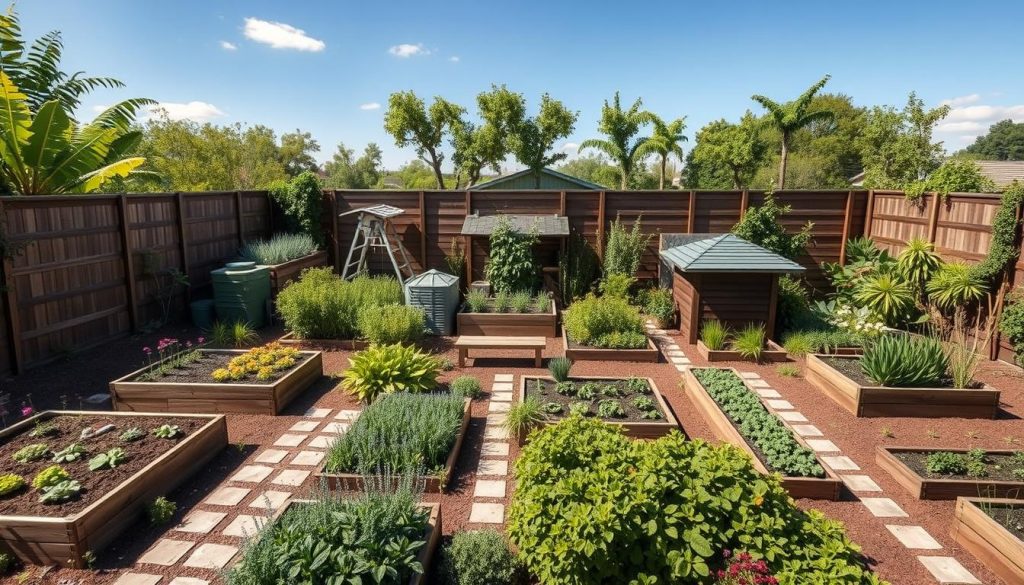
Creating Garden Zones
Creating garden zones is crucial. It groups plants by their needs. This reduces the need for harmful chemicals, making your garden greener.
Using Permaculture Principles
Permaculture adds to your garden’s sustainability. It uses natural patterns and reduces waste. This makes your garden not just beautiful but also eco-friendly.
| Garden Zone | Plant Requirements | Sustainable Gardening Tips |
|---|---|---|
| Vegetable Garden | Full sun, well-draining soil | Use companion planting, crop rotation |
| Herb Garden | Partial shade, moist soil | Use natural pest control, mulching |
| Flower Garden | Full sun, well-draining soil | Use native plants, reduce water usage |
Water Conservation Techniques
Exploring eco-friendly gardening, I focus on water conservation. Using organic garden practices like collecting rainwater cuts down water use. This method is good for the environment and saves money on water bills.
Rain barrel systems are a great way to save water. They collect rainwater for irrigation and other uses. This reduces our need for municipal water and lessens stormwater runoff.
Rain Barrel Systems
Rain barrel systems are simple to set up and care for. They use a large barrel to catch rainwater from your roof. This water can water plants, wash cars, or fill ponds.
Drip Irrigation Basics
Drip irrigation is very efficient. It delivers water right to the plant roots, cutting down on evaporation and runoff. This method saves water and prevents overwatering, which harms plants. Drip irrigation helps plants grow well while using less water.
Here are some benefits of using drip irrigation:
- Conserves water by delivering it directly to the roots of the plants
- Reduces evaporation and runoff
- Promotes healthy plant growth
- Decreases the risk of overwatering
By using these water-saving techniques, we can make our gardens more sustainable. This not only helps the environment but also ensures our plants grow strong and healthy.
Building Healthy Soil
As I work on my sustainable garden, I’ve learned how key healthy soil is. It’s vital for a garden to grow well and be good for the planet. By focusing on sustainable design, my garden looks great and helps the environment.
I’ve started composting at home. This means turning food waste and yard clippings into a rich soil mix. It cuts down on waste and gives my garden a boost. Composting is a big part of gardening the green way, as it cuts down on chemical fertilizers and keeps the soil healthy.
Composting at Home
- Collect food waste and yard trimmings
- Create a compost pile or bin
- Allow the materials to break down into a nutrient-rich soil amendment
Understanding Soil pH Levels
Knowing about soil pH is also crucial. The pH level affects how well plants can use nutrients. Keeping the pH balanced helps my plants grow strong and healthy.
| Soil pH Level | Effect on Plant Growth |
|---|---|
| Too acidic (pH 0-5.5) | Can be toxic to plants |
| Optimal (pH 5.5-7.0) | Supports healthy plant growth |
| Too alkaline (pH 7.0-14) | Can lead to nutrient deficiencies |
Pest Management in a Sustainable Garden
Creating a sustainable garden means managing pests well. I’ve learned that using natural methods can keep my garden healthy. This includes using a mix of techniques to control pests.
Physical barriers like mesh keep pests away from my plants. I also use beneficial insects to fight pests. Organic pesticides like neem oil are another tool in my arsenal.
To improve my garden, I attract helpful insects. Bees and butterflies pollinate and control pests. This approach makes my garden diverse and healthy, reducing pesticide use.
- Ladybugs, which prey on aphids and other small insects
- Lacewings, which feed on whiteflies and other pests
- Parasitic wasps, which control pest populations by laying their eggs inside the bodies of pests
By following these sustainable gardening tips, my garden is now a thriving ecosystem. It’s a safe space for beneficial insects and a great place for my plants to grow.
Implementing Sustainable Practices
To make a garden thrive and be kind to the environment, we must use sustainable practices. It’s key to think about how our actions affect the planet. By following sustainable gardening tips, we can lessen our garden’s impact on the environment.
Keeping a garden healthy involves using crop rotation and diversity. This method changes the plants and crops to make the soil better, prevent erosion, and add variety. For instance, legumes help the soil by adding nitrogen, and marigolds keep nematodes away.
Crop Rotation and Diversity
- Rotate plants and crops to promote soil fertility
- Increase biodiversity by planting a variety of plants
- Use companion planting to deter pests and diseases
Organic Fertilizers and Amendments
Choosing organic fertilizers and amendments is vital for sustainable gardening. These natural options feed your plants well and are better for the planet. Examples include compost, manure, and green sand.
By using these tips, you can have a lovely, eco-friendly garden. It will benefit you and the planet. Always choose sustainability when gardening, and try new things to see what works best.
| Organic Fertilizer | Benefits |
|---|---|
| Compost | Rich in nutrients, improves soil structure |
| Manure | High in nitrogen, phosphorus, and potassium |
| Green Sand | Rich in iron, potassium, and magnesium |
Seasonal Maintenance Tips
To keep your garden thriving all year, follow seasonal maintenance tips. Each season brings different needs for your garden’s health and sustainability. Using eco-friendly gardening and organic practices helps your garden flourish and benefits the environment.
Before winter, clean up your garden, protect plants from frost, and plan for spring. Remove dead plants, prune trees and shrubs, and mulch to keep moisture in and weeds out. In spring, prepare the soil, pick the right plants, and use green gardening methods for a vibrant garden.
Preparing for Winter
- Clean up the garden by removing dead plants and debris
- Protect plants from frost using natural methods such as covering with burlap or bringing potted plants indoors
- Plan for the next growing season by ordering seeds and making a garden plan
Spring Planting Essentials
In spring, start planting new seeds and seedlings. Prepare the soil with compost or manure. Choose plants that fit your climate and soil. Use green gardening methods like companion planting and crop rotation for a strong garden.
| Season | Maintenance Tips |
|---|---|
| Winter | Clean up the garden, protect plants from frost, and plan for the next growing season |
| Spring | Prepare the soil, select the right plants, and use eco-friendly gardening techniques |
Follow these seasonal tips and use organic practices for a sustainable garden. Always choose eco-friendly methods and plants that match your climate and soil. This way, your garden will be beautiful and productive all year.
Resources and Organizations for Sustainable Gardening
Starting your sustainable gardening journey? It’s key to have the right resources and support. Joining local gardening clubs and online communities is very helpful. These groups offer workshops, educational materials, and knowledge from experienced gardeners.
Local Gardening Clubs
Being part of a local gardening club is a smart move. You’ll learn from others who love sustainable garden design. Clubs host events, plant swaps, and educational sessions on sustainable gardening.
By connecting with others, you’ll get practical tips and discover new techniques. This will help you improve your sustainable gardening.
Online Communities and Workshops
There are also online platforms for sustainable gardeners. Websites, forums, and social media groups are great for sharing knowledge. Many organizations provide online workshops and classes on sustainable gardening.
These digital resources keep you informed and inspired. They help you grow your sustainable garden.

